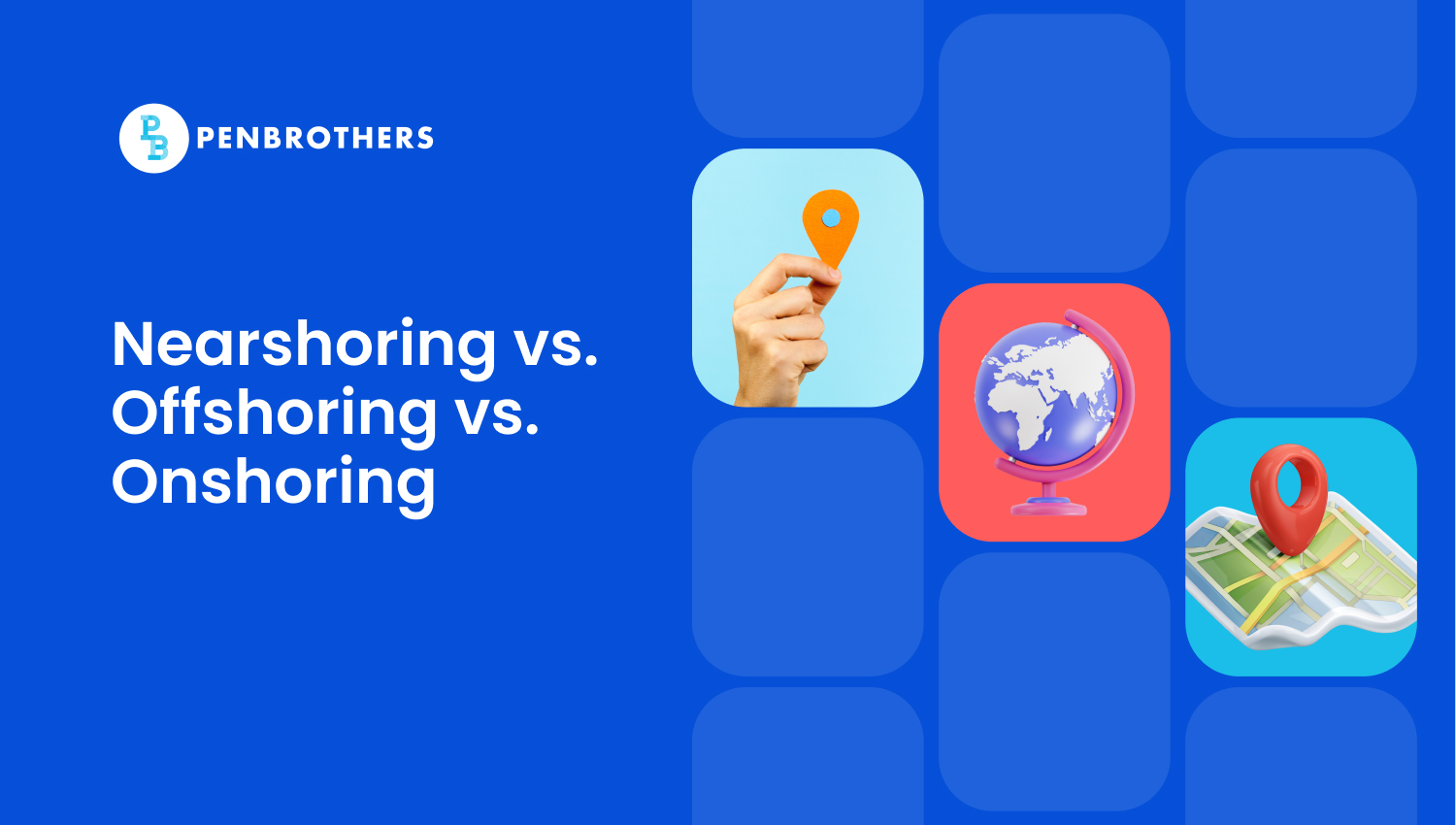What's Inside?
Nearshoring, Offshoring, and Onshoring: How Do They Work?

In the United Kingdom, a survey revealed that 86% of organizations have found hiring “quite” or “very” competitive in 2023. This year, 40% of these organizations also expect “lack of skilled candidates available” to be their greatest recruitment challenge.
But this is not limited to the U.K. According to the ManpowerGroup survey, 75% of employers around the world report difficulty in filling roles.
Luckily, business leaders have three options for solving their talent acquisition challenges: onshoring, nearshoring, and offshoring.
Businesses worldwide have been leveraging these different models to hire top-notch talents with specialized and highly in-demand skills. This is especially true for specific industries with hiring challenges, such as software development and digital marketing.
Nearshoring vs. Offshoring vs. Onshoring: What are the Differences?
Nearshoring takes advantage of resources from a nearby country within the same region. For instance, the U.S. is advancing its nearshoring priorities in countries in Central America with Special Economic Zones. Policymakers and business leaders in the U.S. focus on diversifying supply chains to pull Asia-based supply chains away from China and nearshore them to the Americas for greater economic security.
Offshoring, on the other hand, is similar—only that it moves certain business processes, such as hiring talent, to geographically distant countries.
Meanwhile, onshoring, also sometimes referred to as domestic outsourcing, transfers specific business operations to another city within the same country.
Onshore vs. nearshore vs. offshore―one can assume they differ only in distance. All three have many similarities but are entirely different talent acquisition strategies, especially in their unique ways of helping you achieve your business goals.
The Meaning of Nearshoring and How It Can Help Your Business
Nearshoring involves outsourcing tasks to a nearby country, usually on the same continent. Your nearshore partner is a little bit closer to you, but it’s still outside your country.
For example, if your company is in California, you can outsource your work to a nearshore company in Mexico. Mexico’s northern states are a top destination for companies who want to position their operations or link with suppliers who are closer to the U.S. and shift their production capacity away from China.

Most manufacturing, e-commerce, financial services, and software development companies nearshore their production, customer support centers, and software development tasks.
The Advantages of Nearshoring
Nearshoring is ideal if you want to cut costs and increase efficiency by outsourcing to a nearby location with lower labor costs. Businesses benefit from nearshoring because of geographical proximity, leveraging key resources while reducing expenses.
You can make more frequent but less expensive trips for in-person communication and face-to-face meetings. Because you are in the same time zone, you can communicate and make decisions quickly, pivot strategies, and grab new opportunities just as fast. Thus, your business becomes more agile and flexible enough to scale up or down easily.
The Disadvantages of Nearshoring
Nearshoring provides more control over the entire business operation or project management process. However, every business owner must also know the disadvantages of nearshoring.
For instance, the quality of nearshoring services is not guaranteed and will depend on how much research you devote to finding the best nearshoring solutions provider in that region.
Moreover, being in close geographical proximity to your nearshore partner also puts your business at risk if there are any ongoing social, economic, or political challenges in its location.
Read more: Hiring and Working With Offshore Teams: Know the Real Deal
What is Offshoring and Its Pros and Cons?
Like nearshoring, offshoring moves business operations or services to a different location. But the major difference between offshoring and nearshoring is that the offshoring partner is not nearby. It’s in a more distant and entirely different geographic location.
The Advantages of Offshoring
Offshoring also has advantages and disadvantages.
When managed properly, the difference in time zones can become more of a benefit than a setback.
You can run critical business functions and leverage the time zone difference to get work done while your in-house team sleeps. For example, a company operating in California with an offshore team in the Philippines is 16 hours behind. There’s a 1-hour overlap if the local and offshore teams work within the typical 9-to-6 schedule. The teams can maximize that overlapping time by conducting daily virtual meetings for alignment, progress tracking, and tackling potential issues—and then spend the rest of the day on deep work.

It also allows your business to operate continuously and provide 24/7 customer service and staffing flexibility, so you miss no growth opportunities. As a result, you increase your productivity and improve customer satisfaction.
As far as offshoring companies go, you also benefit from the wide range of options. Offshoring destinations like the Philippines have a vast, diverse, highly skilled, and English-proficient talent pool. With their specialized skills and proven competence, you can build multi-disciplinary offshore teams efficiently and effectively at reduced costs.
See also:
- Find Out the Cost Savings You’ll Get from Offshore Staffing
- 5 Non-Negotiables When Building A Filipino Offshore Team
The Disadvantages of Offshoring
There are downsides to consider too. Unlike nearshoring where you can exercise more control, offshoring is more challenging because of the distance and the time difference. You need to invest in technology that enables asynchronous working, so your operations keep running despite the time and geographical boundaries.
Additionally, although offshoring countries like the Philippines have English as their second language, there may still be challenges like language and cultural barriers that can interfere with the way your in-house team and remote team collaborate.
See also: Offshore Staffing Trends in 2024: KPO, Automation, and More
How Onshoring Works and Its Pros and Cons

Onshoring makes sense if you want to outsource to a third-party service without the challenges that nearshoring and offshoring pose. It involves moving your business processes to another location within the country, usually somewhere more affordable or strategic for your operations.
Onshoring vs Offshoring: Which is Better for Your Business?
Onshoring is ideal for startups because it gives you control, security, and coordination over many business processes.
There’s also increased efficiency, cooperation, and coordination since your onshoring partners speak the same language and come from the same cultural background. Along with this, there’s no time zone difference, so everybody can work in sync.
Unlike offshoring, onshoring doesn’t have to factor in overseas travel and living expenses. Proximity to your onshore partner reduces costs, from shipping, inventory holding, and transportation to customs duty.
You’ll also encounter fewer problems regarding domestic regulations, taxes, and financial laws, as they will be subject to the same laws, rules, and regulations. Plus, you’ll be tapping into the native labor force and using domestic facilities, infrastructure, and resources.
The Disadvantages of Onshoring
Despite its significant cost savings, onshoring has higher production costs than offshoring and nearshoring. It can be a competitive disadvantage, especially when more affordable options exist globally.
Moreover, the localized approach of onshoring can potentially limit not just your global market presence but also your access to a diverse, highly skilled global talent pool.
Your onshore operations can also be affected whenever the country has supply chain disruptions, such as labor strikes, natural disasters, and economic fluctuation.
Nearshoring vs. Offshoring vs. Onshoring: In a Nutshell
Still deciding on which talent sourcing strategy is the best for your company? Refer to this table that summarizes the key differences between nearshoring, offshoring, and onshoring.
| CRITERIA | NEARSHORING | OFFSHORING | ONSHORING |
| Remote Team Location | Neighboring Country | Geographically distant country, usually on a different continent | Same country or region |
| Time Zone Difference | Little to non | 5 to 16 hours | None |
| Costs | Medium | Low | Medium to High |
| Travel Costs | Medium | High | Low |
| Culture Fit | High | Medium to Low | High |
| Cost Savings | Medium | High | Low |
| Talent Pool | Larger pool of candidates | Larger pool of candidates at reduced hiring costs | Limited talent, skills shortage, and expensive |
You don’t have to choose one over the others—it’s actually strategic to combine two or all of these strategies to maximize their benefits.
For instance, nearshoring and offshoring can be complementary and be considered part of one’s talent acquisition strategy, according to Nicolas Bivero, CEO and co-founder of Penbrothers, the #1 Fastest-Growing Company in the Philippines.
“Offshoring isn’t an alternative to nearshoring; it’s a natural extension. By building a team that includes local, nearshore, and offshore talents, you’re strategically combining their strengths to create a more dynamic, versatile, and robust workforce,” says Nicolas.
Read more about Nicolas’ thoughts on nearshoring, onshoring, and offshoring here.
Final Thoughts
Whether nearshoring, offshoring, or onshoring, all can benefit your business. To determine the best business strategy, define your priorities, challenges, and what you’re trying to achieve for your company. Is it primarily to cut costs, hire the best talents, or reach a global audience? Only then can you decide on which strategy to adopt.
It can be overwhelming to get down to the nitty-gritty of each talent acquisition model. This is why it’s crucial to work with an experienced and strategic partner to guide you through the entire process and jump through the hoops for you.






